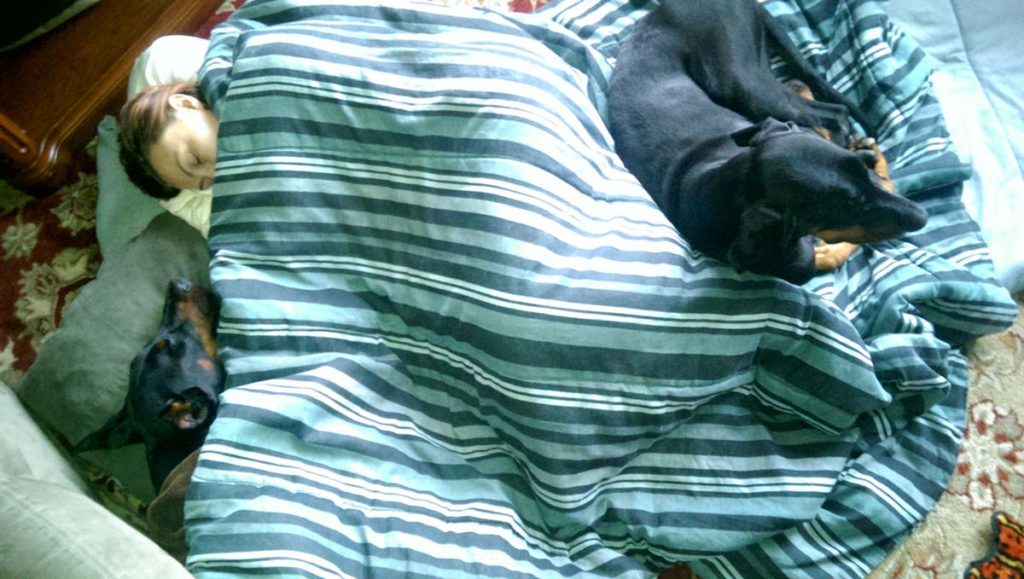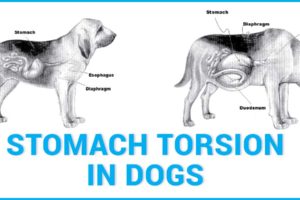
Bloat in Dobermanns is a very common health issue that considers to be hereditary. My dog Nitro had several ancestors in the pedigree with bloat, so it was a matter of time for him. Unfortunately, until he actually bloated – I wasn’t aware of the problem. Below is my experience with bloat in Dobermanns.
If you are looking for description of bloat and how to prevent it – check out my article Stomach torsion in dogs.
Once a year we used to escape the craziness of Silicon Valley to enjoy a simpler lifestyle at a private ranch in Parkfield, California – riding horses, rounding cattle, having a few laughs by the campfire. My dog – Nitro – loved these trips. He loved running free at a full speed across the endless fields, diving in and out of the tall grass, looking for squirrels, or rounding occasionally lost cows. He was a year and a half old during that trip and we were actively working on practicing tracking for his Schutzhund training.
It was a gorgeous October morning – sunny, quiet, and peaceful. Nitro was eager to start the day – pacing as I was getting dressed in a small bungalow we’ve rented. He was looking forward to go for a walk.
I laid a short track right outside the bungalow. Nitro wasn’t too crazy about tracking, so I had to keep him surprised by introducing new bait on the track from time to time. We had a rule – if he does well on the track, he gets his yummy meal right away.
Going into the track the dog should be calm. But I could see that Nitro was getting excited – he could smell the new bait and was pulling me hard to the start flag (beginning of the track). As planned – tracking went well and I had to keep my part of the bargain – give him his meal right away.
Nitro always had a crazy food drive. He could “inhale” a bowl of food within 11 seconds. I’ve never had a dog so overly driven to eat his food. At home I always fed him on a raised feeder to minimize gulping and keep his body steady while eating. That morning – I didn’t have the raised feeder with me – for the first time in his life he had to eat from the ground level. He eagerly began biting into his food – I feed raw diet – lowering his head down to get a bite, and raising it up to swallow. After a couple of bites he suddenly stopped and backed off from the bowl. This immediately caught my attention as he never backed off from his food until the bowl was licked clean. He looked at me, made a step towards the food, but then backed off completely. Something was wrong. The look on his face was worrisome.
My initial thought was he had swallowed a bee and it stung him inside. I looked in his mouth but didn’t see anything unusual. I decided to pour some water in his throat to flush whatever was bothering him. Water came back up right away. I tried again – same outcome. Water wasn’t going down as if something was blocking it.
I’ve heard about colic in horses – when gas causes a stomach twist – but I never thought it applies to dogs. Though, I’ve tried to do what they do to horses – rotate him on his back. I tried to make him lie down, but he was really stiff in his body. I managed to put him on his side and rotate around his back. After he got up – he was keeping away from me, but would not sit or lie down. His back was getting slightly arched and he kept his head down. I began to notice that his belly was getting larger. I checked his lower eye leads – they were getting pale. At that point it was about 30 minutes since he quit eating. I didn’t know what was wrong with him, but it was absolutely clear it was something major.
The ranch where we were staying was about an hour away from nearest town (San Miguel). On top of that – I had no cell reception there – no google to look up for information or for veterinary clinics in the area. I put Nitro in the car and began driving – as gently as I could on those country dirt roads. I had to stop a few times and take him out of the car – the sounds he was making indicated he was in pain and was trying to throw up. Nothing was coming out.
As soon as I got reception on my phone, I googled vet clinics in the area. One was close by and I stepped up on the gas pedal as soon as I hit the paved road. I knew he needed to be X-rayed in order to diagnose what was wrong with him. The first clinic didn’t have an X-ray machine but based on the description of symptoms I gave them – they told me to drive to emergency clinic that has a surgeon on duty – to Atascadero Pet Hospital in Atascadero, California. It was another 30 minutes drive. Driving there felt like eternity. My mind was racing.
When I got to the emergency hospital – the look on my face was enough for the staff to take me ahead of the line. They took Nitro in right away and X-rayed him. The diagnosis was Gastric dilation volvulus – stomach bloat – and the clock was ticking.
I barely had any time to research information on the phone, but the surgeon was rushing me to make up my mind. I texted a couple of people from my club as I felt that I can trust their judgement. The response was unanimous – do the surgery immediately.
It is not my practice to hand my dog over to the nurses and stay in the waiting room. I told the vet that I’m scrubbing in and will stay with my dog through the surgery. I am very grateful to the surgeon Aaron Schechter from Atascadero Pet Hospital, who understood the bond I had with my dog and the stressful situation I was in. After certain consideration he accepted my determination and let me be present during the surgery.
They ran some tests on Nitro to make sure he is healthy enough to survive the surgery, and prepped him and me for the surgery. The rest – is history. Aaron Schechter did an amazing job and was great to explain what he was doing to my dog during and after the surgery. There were no complications during surgery, but they still kept Nitro for extra couple of days to ensure full recovery. I stayed with Nitro at the clinic until he woke up, so he can see that I’m with him. I had to leave eventually (they didn’t let me stay overnight there), but at least I left my dog telling him I’ll be back in the morning. I had a command for cases when I had to leave him alone at home. He knew what it meant.

First days at home after the surgery I kept an eye on Nitro for symptoms of distress (pain) and to prevent him from moving too much. I slept close to him for the first week until he got back to his normal self again.
Nitro fully recovered. He was back to normal in a week after the surgery. I had to restrain him from running to protect his stitched stomach from ripping apart. The surgery didn’t influence his training or his health in any way. He grew to be an IPO3 High in Trial Dobermann at the National IPO Championship.
During the surgery they stitched his stomach to the side wall to prevent future incidents of bloat. The procedure is called gastropexy. On my end – I did enough research to take measures to reduce the risk of bloat. I described these preventive measures in my article Stomach torsion in dogs.
Bloat in Dobermanns can be devastating, but if you act fast – there is high probability your dog will fully recover.
